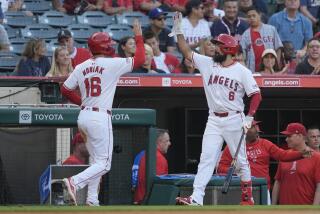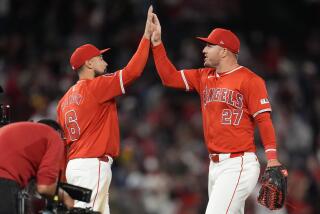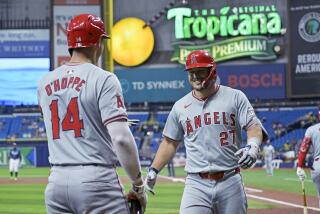Angels have no second thoughts
BALTIMORE — Howie Kendrick was on first base in the second inning of a June 18 game against Houston when Shea Hillenbrand grounded a single through the shortstop hole. Kendrick never slowed around second, raced to third and beat left fielder Carlos Lee’s throw, which was a few feet wide of the bag.
A split-second decision to make a daring dash to third, a gamble few major leaguers would take?
Hardly.
The seeds for Kendrick’s aggressive baserunning -- which enabled him to score on Mike Napoli’s infield single -- were planted years ago in the minor leagues, during spring training and fall instructional leagues, and the decision to go was based on a series of calculations weighed before the series against the Astros.
“It’s one of the things they’re always harping on, be aggressive on the basepaths, know when to go first to third, and if you make an aggressive mistake, learn from it,” Kendrick said. “When you get to the major leagues, they expect us to have that instilled in us.”
Kendrick, Reggie Willits, Chone Figgins, Napoli, Erick Aybar and Casey Kotchman are among the first generation of Angels big leaguers to be raised under Manager Mike Scioscia’s organizational baserunning philosophy, and those who didn’t come up with the Angels learn quickly.
The Angels want to run. They want to pressure opponents, and not just with the stolen base. They do it by going from first to third on singles, an often overlooked part of the game that helps the Angels maximize offense in the face of their limited power.
Entering today’s game at Baltimore, the Angels have gone first to third on singles 57 times this season, most in the major leagues, and have been caught three times. Despite getting swept by Kansas City this week, the Angels rank fourth in the league in runs.
Since Scioscia took over as manager in 2000, the Angels, according to STATS LLC, have gone first to third on singles 759 times through Sunday’s games, second in the big leagues behind Colorado (777).
Since 2002, the year they won the World Series with more of a go-go approach, the Angels have gone first to third on singles 571 times, most in the major leagues.
“From day one of spring training, Mike tells them he wants them to go first to third, and it carries into the season,” third base coach Dino Ebel said. “When I managed [triple-A] Salt Lake in 2005, that’s what we did. These guys do it every day, from rookie ball on up, and they’re not going to get yelled at if they’re thrown out.”
Ebel spent 17 years in the Dodgers’ organization as a minor league player, coach and manager before joining the Angels in 2005.
“What a difference ... what a difference,” he said. “The Dodgers wanted to go first to third, but it was always, ‘Don’t get thrown out at third.’ Here, they encourage you to go. They make outfielders have to make a perfect throw. It’s an aggressive style, and it works. I’m a true believer.”
Center fielder Gary Matthews Jr., who played in six organizations and spent three seasons at Texas before signing with the Angels last winter, was a quick convert.
“Absolutely, it’s emphasized more here,” Matthews said. “We had a more careful running game in Texas. They could wait on the three-run home run, so there was no need to take many chances on the basepaths. We literally ran the bases more in spring training here than any other team I’ve been on. They said don’t worry about making mistakes, be aggressive, it’s OK if you get thrown out.”
It takes more than speed to successfully go from first to third. In fact, speed might be one of the least important factors. It begins with scouting and preparation.
“We keep a log on outfielders who charge the ball and who don’t charge, who have accurate arms and powerful arms,” Scioscia said. “We take all that into consideration. This is not a blind experiment to say hey, run until you get thrown out.”
A good secondary lead, those hop steps toward second as the pitch is delivered, is important, as is making an efficient turn around second. After contact, the runner must “recognize where the ball is hit, know who the outfielders are and the depth they’re playing, how hard the ball is hit, how many outs there are,” Matthews said.
How an outfielder fields the ball is important too.
“Whether the outfielder has to move to his left or right, whether he has to rotate his body to throw can tell you if you can go from first to third,” Kendrick said.
That came into play against Houston. Lee has an average arm, and because he throws right-handed and fielded the ball on his left, he had to twist his body to throw.
“A lot of guys are surprised by it, even though they know we like to run,” Kendrick said. “And how many times does an outfielder make a great throw? That’s not to say they don’t, but when you put that pressure on them ... you’re going to be successful most of the time.”
And if not? No worries.
“In this game, you have to think about making plays, you can’t worry about making mistakes,” Scioscia said. “At times, a guy will get thrown out, but in the bigger scheme, the bases we’re going to take will far outweigh that occasional misread. And it depends on what you call a mistake.
“If the outfielder puts the ball right on the money, he’s out by a quarter-step and it’s a bang-bang play, that’s not a mistake. That’s baseball. If you’re out by four or five steps, it’s ugly, it’s a misread, but in the big picture, that aggressiveness is going to help us more than the occasional blunder will hurt.”
--
--
Begin text of infobox
First to third
Most times going first to third on a single:
*--* SINCE 2000
*--*
Colorado Rockies...777
ANGELS...759
St. Louis Cardinals...730
Kansas City Royals...717
Minnesota Twins...706
Note: Through Sunday’s games
*--* SINCE 2002
*--*
ANGELS...571
St. Louis Cardinals...529
New York Yankees...524
Colorado Rockies...518
Kansas City Royals...514
Note: Through Sunday’s games
*--* 2007
*--*
ANGELS...57
Cleveland Indians...50
Kansas City Royals...49
St. Louis Cardinals...47
Colorado Rockies...45
Atlanta Braves...44
Houston Astros...44
Minnesota Twins...44
Oakland Athletics...44
San Diego Padres...44
Tampa Bay Devil Rays...43
Detroit Tigers... 42
DODGERS...41
New York Yankees... 41
THE BOTTOM FIVE
Philadelphia Phillies...29
Seattle Mariners...28
New York Mets...26
Pittsburgh Pirates...23
Florida Marlins...23
Note: Through Wednesday’s games
--
Source: STATS LLC
More to Read
Go beyond the scoreboard
Get the latest on L.A.'s teams in the daily Sports Report newsletter.
You may occasionally receive promotional content from the Los Angeles Times.






